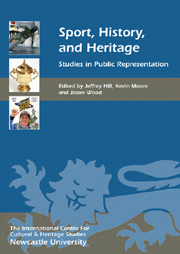Book contents
- Frontmatter
- Contents
- List of Illustrations
- Acknowledgments
- Sport, History and Heritage: An Investigation into the Public Representation of Sport – Editors' General Introduction
- HISTORY, HERITAGE AND SPORT
- MUSEUMS AND THE REPRESENTATION OF SPORT
- SURVIVALS AND LEGACIES: SPORT, HERITAGE AND IDENTITY
- Afterword: History and Heritage in Sport
- List of Contributors
- Index
- HERITAGE MATTERS
Afterword: History and Heritage in Sport
Published online by Cambridge University Press: 05 April 2013
- Frontmatter
- Contents
- List of Illustrations
- Acknowledgments
- Sport, History and Heritage: An Investigation into the Public Representation of Sport – Editors' General Introduction
- HISTORY, HERITAGE AND SPORT
- MUSEUMS AND THE REPRESENTATION OF SPORT
- SURVIVALS AND LEGACIES: SPORT, HERITAGE AND IDENTITY
- Afterword: History and Heritage in Sport
- List of Contributors
- Index
- HERITAGE MATTERS
Summary
I will begin my short reflection on this timely, varied and innovative collection with a simple generalisation: history is how we explain the past; heritage is how we preserve it. Preserving the past comes in many forms, from acts of personal recollection to collective rites of public commemoration. In terms of sport this can range from memories of great matches or players to putting up statues outside stadia which themselves have become a focus of sporting heritage.
A simple distinction between history and heritage, however, is complicated by the fact that much popular ‘history’ is probably better characterised as ‘heritage’ in the sense that it evokes or records the past rather than analyses it. History as an academic discipline restricted to a relatively small readership is very different from heritage as a way of bringing the past to life through memory and material culture. Hence the heritage approach tends to reach a wider audience and have more influence on popular understandings of the past than conventional history. Few works of sporting heritage – the term itself was rarely used – appeared before the 1950s, when publishers such as Stanley Paul realised there was a lucrative market in the formulaic sports biography or the adulatory club history. The sheer volume of such work is striking, even if the literary or historical standards are low. The heritage of sport has frequently been conveyed in a simple biographical form that focuses narrowly on the experience of the player rather than the response of the fan.
- Type
- Chapter
- Information
- Sport, History, and HeritageStudies in Public Representation, pp. 263 - 266Publisher: Boydell & BrewerPrint publication year: 2012



